warning YAMAHA MT-125 2015 User Guide
[x] Cancel search | Manufacturer: YAMAHA, Model Year: 2015, Model line: MT-125, Model: YAMAHA MT-125 2015Pages: 96, PDF Size: 7.28 MB
Page 22 of 96
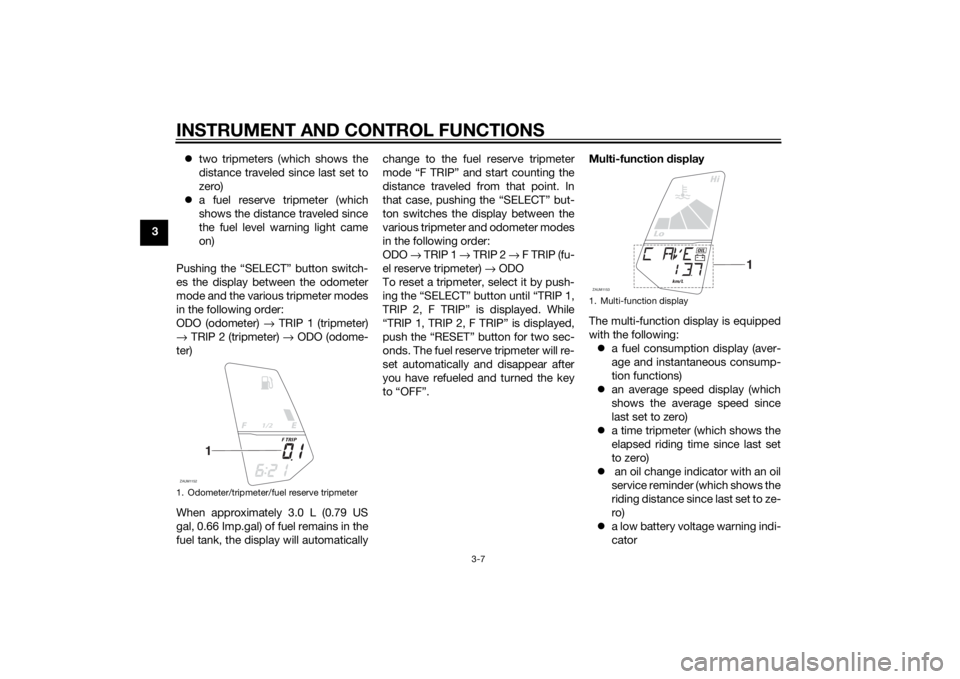
INSTRUMENT AND CONTROL FUNCTIONS
3-7
3two tripmeters (which shows the
distance traveled since last set to
zero)
a fuel reserve tripmeter (which
shows the distance traveled since
the fuel level warning light came
on)
Pushing the “SELECT” button switch-
es the display between the odometer
mode and the various tripmeter modes
in the following order:
ODO (odometer) → TRIP 1 (tripmeter)
→ TRIP 2 (tripmeter) → ODO (odome-
ter)
When approximately 3.0 L (0.79 US
gal, 0.66 Imp.gal) of fuel remains in the
fuel tank, the display will automaticallychange to the fuel reserve tripmeter
mode “F TRIP” and start counting the
distance traveled from that point. In
that case, pushing the “SELECT” but-
ton switches the display between the
various tripmeter and odometer modes
in the following order:
ODO → TRIP 1 → TRIP 2 → F TRIP (fu-
el reserve tripmeter) → ODO
To reset a tripmeter, select it by push-
ing the “SELECT” button until “TRIP 1,
TRIP 2, F TRIP” is displayed. While
“TRIP 1, TRIP 2, F TRIP” is displayed,
push the “RESET” button for two sec-
onds. The fuel reserve tripmeter will re-
set automatically and disappear after
you have refueled and turned the key
to “OFF”.Multi-function display
The multi-function display is equipped
with the following:
a fuel consumption display (aver-
age and instantaneous consump-
tion functions)
an average speed display (which
shows the average speed since
last set to zero)
a time tripmeter (which shows the
elapsed riding time since last set
to zero)
an oil change indicator with an oil
service reminder (which shows the
riding distance since last set to ze-
ro)
a low battery voltage warning indi-
cator
1. Odometer/tripmeter/fuel reserve tripmeterZAUM1152
1/2
F TRIP
1
1. Multi-function displayZAUM1153
km/L
Lo
Hi
OIL
1
U5D7E4E0.book Page 7 Thursday, July 10, 2014 3:01 PM
Page 23 of 96
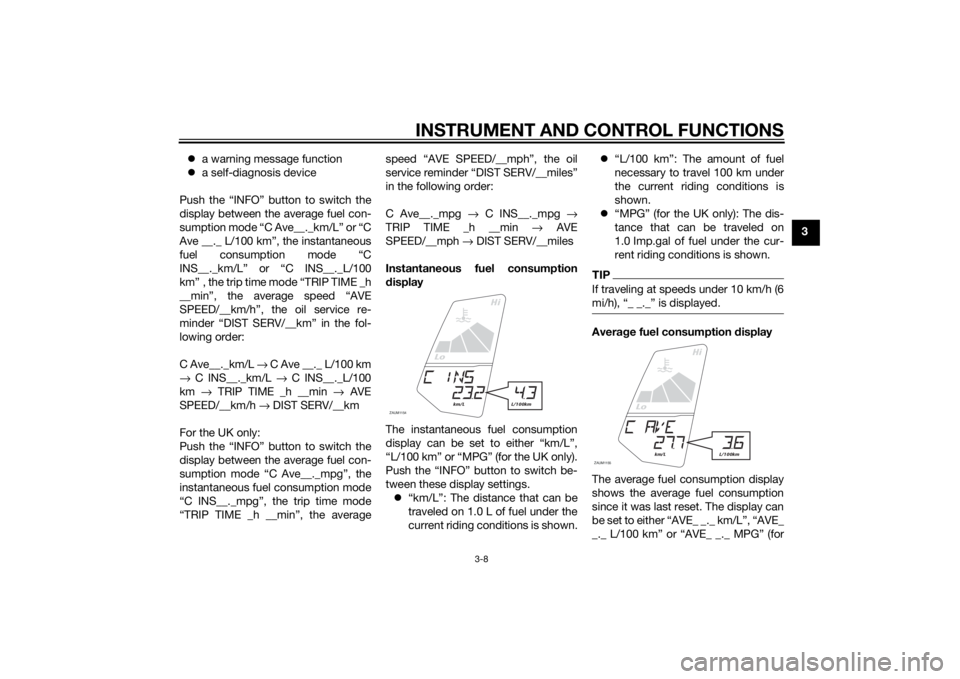
INSTRUMENT AND CONTROL FUNCTIONS
3-8
3 a warning message function
a self-diagnosis device
Push the “INFO” button to switch the
display between the average fuel con-
sumption mode “C Ave__._km/L” or “C
Ave __._ L/100 km”, the instantaneous
fuel consumption mode “C
INS__._km/L” or “C INS__._L/100
km” , the trip time mode “TRIP TIME _h
__min”, the average speed “AVE
SPEED/__km/h”, the oil service re-
minder “DIST SERV/__km” in the fol-
lowing order:
C Ave__._km/L → C Ave __._ L/100 km
→ C INS__._km/L → C INS__._L/100
km → TRIP TIME _h __min → AVE
SPEED/__km/h → DIST SERV/__km
For the UK only:
Push the “INFO” button to switch the
display between the average fuel con-
sumption mode “C Ave__._mpg”, the
instantaneous fuel consumption mode
“C INS__._mpg”, the trip time mode
“TRIP TIME _h __min”, the averagespeed “AVE SPEED/__mph”, the oil
service reminder “DIST SERV/__miles”
in the following order:
C Ave__._mpg → C INS__._mpg →
TRIP TIME _h __min → AVE
SPEED/__mph → DIST SERV/__miles
Instantaneous fuel consumption
display
The instantaneous fuel consumption
display can be set to either “km/L”,
“L/100 km” or “MPG” (for the UK only).
Push the “INFO” button to switch be-
tween these display settings.
“km/L”: The distance that can be
traveled on 1.0 L of fuel under the
current riding conditions is shown.“L/100 km”: The amount of fuel
necessary to travel 100 km under
the current riding conditions is
shown.
“MPG” (for the UK only): The dis-
tance that can be traveled on
1.0 Imp.gal of fuel under the cur-
rent riding conditions is shown.
TIPIf traveling at speeds under 10 km/h (6
mi/h), “_ _._” is displayed.Average fuel consumption display
The average fuel consumption display
shows the average fuel consumption
since it was last reset. The display can
be set to either “AVE_ _._ km/L”, “AVE_
_._ L/100 km” or “AVE_ _._ MPG” (for
ZAUM1154
km/L L/100km
Lo
Hi
ZAUM1155
km/L
Lo
Hi
L/100km
U5D7E4E0.book Page 8 Thursday, July 10, 2014 3:01 PM
Page 25 of 96
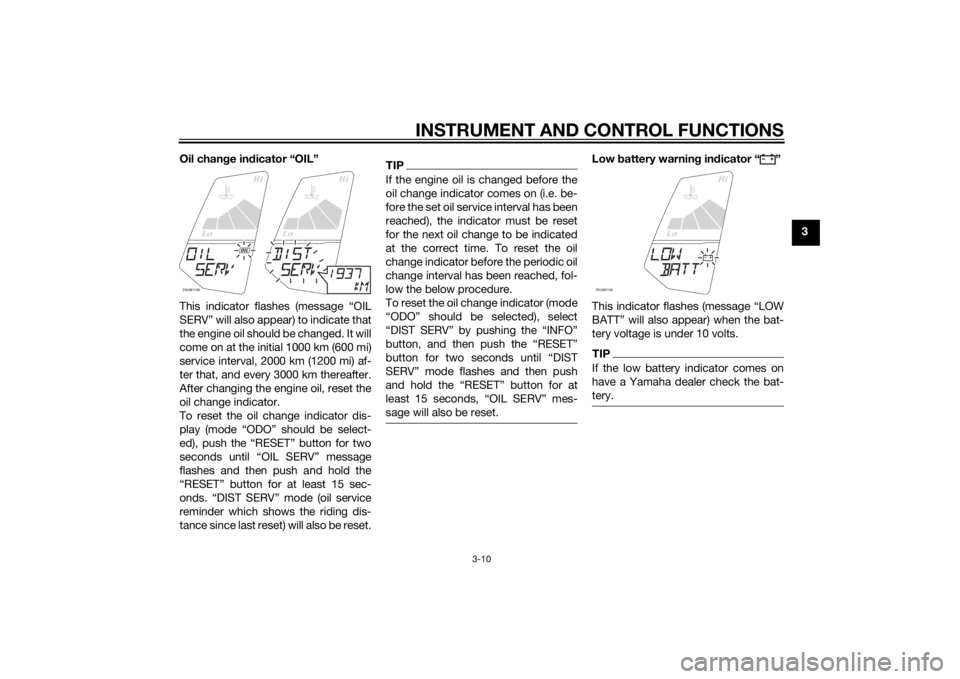
INSTRUMENT AND CONTROL FUNCTIONS
3-10
3 Oil change indicator “OIL”
This indicator flashes (message “OIL
SERV” will also appear) to indicate that
the engine oil should be changed. It will
come on at the initial 1000 km (600 mi)
service interval, 2000 km (1200 mi) af-
ter that, and every 3000 km thereafter.
After changing the engine oil, reset the
oil change indicator.
To reset the oil change indicator dis-
play (mode “ODO” should be select-
ed), push the “RESET” button for two
seconds until “OIL SERV” message
flashes and then push and hold the
“RESET” button for at least 15 sec-
onds. “DIST SERV” mode (oil service
reminder which shows the riding dis-
tance since last reset) will also be reset.
TIPIf the engine oil is changed before the
oil change indicator comes on (i.e. be-
fore the set oil service interval has been
reached), the indicator must be reset
for the next oil change to be indicated
at the correct time. To reset the oil
change indicator before the periodic oil
change interval has been reached, fol-
low the below procedure.
To reset the oil change indicator (mode
“ODO” should be selected), select
“DIST SERV” by pushing the “INFO”
button, and then push the “RESET”
button for two seconds until “DIST
SERV” mode flashes and then push
and hold the “RESET” button for at
least 15 seconds, “OIL SERV” mes-
sage will also be reset.
Low battery warning indicator “ ”
This indicator flashes (message “LOW
BATT” will also appear) when the bat-
tery voltage is under 10 volts.TIPIf the low battery indicator comes on
have a Yamaha dealer check the bat-
tery.
ZAUM1158
Lo
Hi
OIL
Lo
Hi
ZAUM1159
Lo
Hi
U5D7E4E0.book Page 10 Thursday, July 10, 2014 3:01 PM
Page 26 of 96
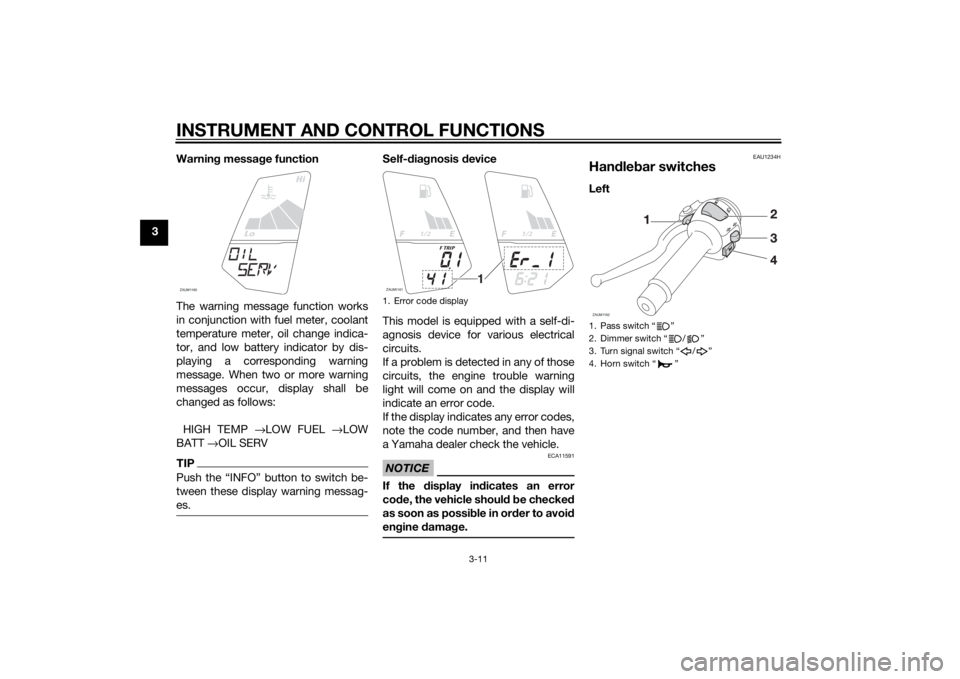
INSTRUMENT AND CONTROL FUNCTIONS
3-11
3Warning message function
The warning message function works
in conjunction with fuel meter, coolant
temperature meter, oil change indica-
tor, and low battery indicator by dis-
playing a corresponding warning
message. When two or more warning
messages occur, display shall be
changed as follows:
HIGH TEMP →LOW FUEL →LOW
BATT →OIL SERV
TIPPush the “INFO” button to switch be-
tween these display warning messag-
es.
Self-diagnosis device
This model is equipped with a self-di-
agnosis device for various electrical
circuits.
If a problem is detected in any of those
circuits, the engine trouble warning
light will come on and the display will
indicate an error code.
If the display indicates any error codes,
note the code number, and then have
a Yamaha dealer check the vehicle.NOTICE
ECA11591
If the display indicates an error
code, the vehicle should be checked
as soon as possible in order to avoid
engine damage.
EAU1234H
Handlebar switchesLeft
ZAUM1160
Lo
Hi
1. Error code displayZAUM1161
1/2
F TRIP
1/2
1
1. Pass switch Ž
2. Dimmer switch / Ž
3. Turn signal switch / Ž
4. Horn switch ŽZAUM1162
U5D7E4E0.book Page 11 Thursday, July 10, 2014 3:01 PM
Page 27 of 96
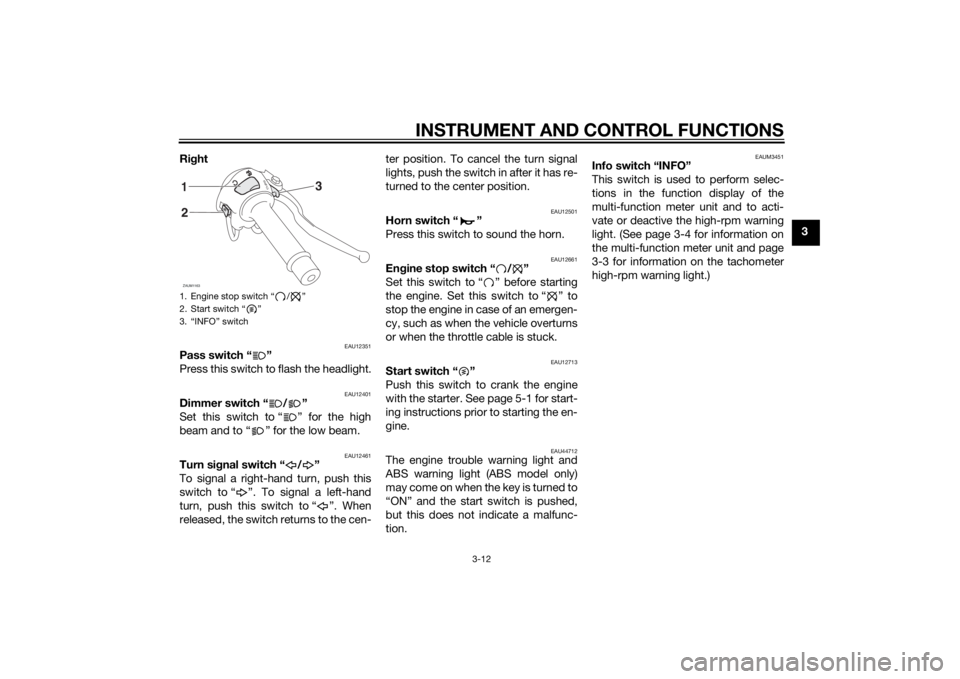
INSTRUMENT AND CONTROL FUNCTIONS
3-12
3 Right
EAU12351
Pass switch “ ”
Press this switch to flash the headlight.
EAU12401
Dimmer switch “ / ”
Set this switch to “ ” for the high
beam and to “ ” for the low beam.
EAU12461
Turn signal switch “ / ”
To signal a right-hand turn, push this
switch to “ ”. To signal a left-hand
turn, push this switch to “ ”. When
released, the switch returns to the cen-ter position. To cancel the turn signal
lights, push the switch in after it has re-
turned to the center position.
EAU12501
Horn switch “ ”
Press this switch to sound the horn.
EAU12661
Engine stop switch “ / ”
Set this switch to “ ” before starting
the engine. Set this switch to “ ” to
stop the engine in case of an emergen-
cy, such as when the vehicle overturns
or when the throttle cable is stuck.
EAU12713
Start switch “ ”
Push this switch to crank the engine
with the starter. See page 5-1 for start-
ing instructions prior to starting the en-
gine.
EAU44712
The engine trouble warning light and
ABS warning light (ABS model only)
may come on when the key is turned to
“ON” and the start switch is pushed,
but this does not indicate a malfunc-
tion.
EAUM3451
Info switch “INFO”
This switch is used to perform selec-
tions in the function display of the
multi-function meter unit and to acti-
vate or deactive the high-rpm warning
light. (See page 3-4 for information on
the multi-function meter unit and page
3-3 for information on the tachometer
high-rpm warning light.)
1. Engine stop switch “ / ”
2. Start switch “ ”
3. “INFO” switchZAUM11631
3
2
I
NFO
U5D7E4E0.book Page 12 Thursday, July 10, 2014 3:01 PM
Page 29 of 96
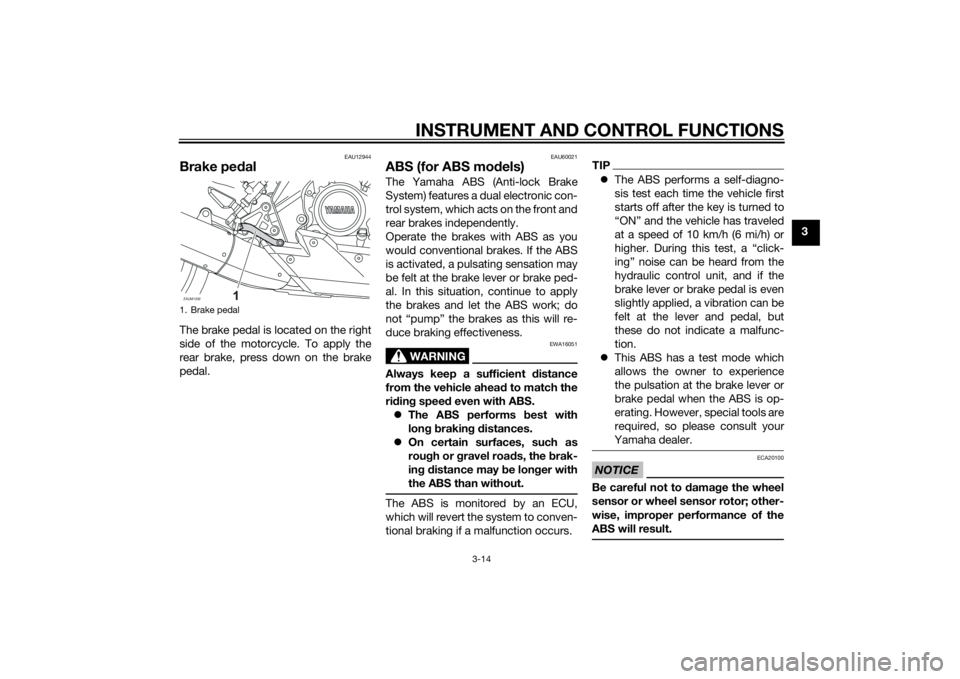
INSTRUMENT AND CONTROL FUNCTIONS
3-14
3
EAU12944
Brake pedalThe brake pedal is located on the right
side of the motorcycle. To apply the
rear brake, press down on the brake
pedal.
EAU60021
ABS (for ABS models)The Yamaha ABS (Anti-lock Brake
System) features a dual electronic con-
trol system, which acts on the front and
rear brakes independently.
Operate the brakes with ABS as you
would conventional brakes. If the ABS
is activated, a pulsating sensation may
be felt at the brake lever or brake ped-
al. In this situation, continue to apply
the brakes and let the ABS work; do
not “pump” the brakes as this will re-
duce braking effectiveness.
WARNING
EWA16051
Always keep a sufficient distance
from the vehicle ahead to match the
riding speed even with ABS.
The ABS performs best with
long braking distances.
On certain surfaces, such as
rough or gravel roads, the brak-
ing distance may be longer with
the ABS than without.The ABS is monitored by an ECU,
which will revert the system to conven-
tional braking if a malfunction occurs.
TIPThe ABS performs a self-diagno-
sis test each time the vehicle first
starts off after the key is turned to
“ON” and the vehicle has traveled
at a speed of 10 km/h (6 mi/h) or
higher. During this test, a “click-
ing” noise can be heard from the
hydraulic control unit, and if the
brake lever or brake pedal is even
slightly applied, a vibration can be
felt at the lever and pedal, but
these do not indicate a malfunc-
tion.
This ABS has a test mode which
allows the owner to experience
the pulsation at the brake lever or
brake pedal when the ABS is op-
erating. However, special tools are
required, so please consult your
Yamaha dealer.NOTICE
ECA20100
Be careful not to damage the wheel
sensor or wheel sensor rotor; other-
wise, improper performance of the
ABS will result.
1. Brake pedalZAUM1202
U5D7E4E0.book Page 14 Thursday, July 10, 2014 3:01 PM
Page 30 of 96
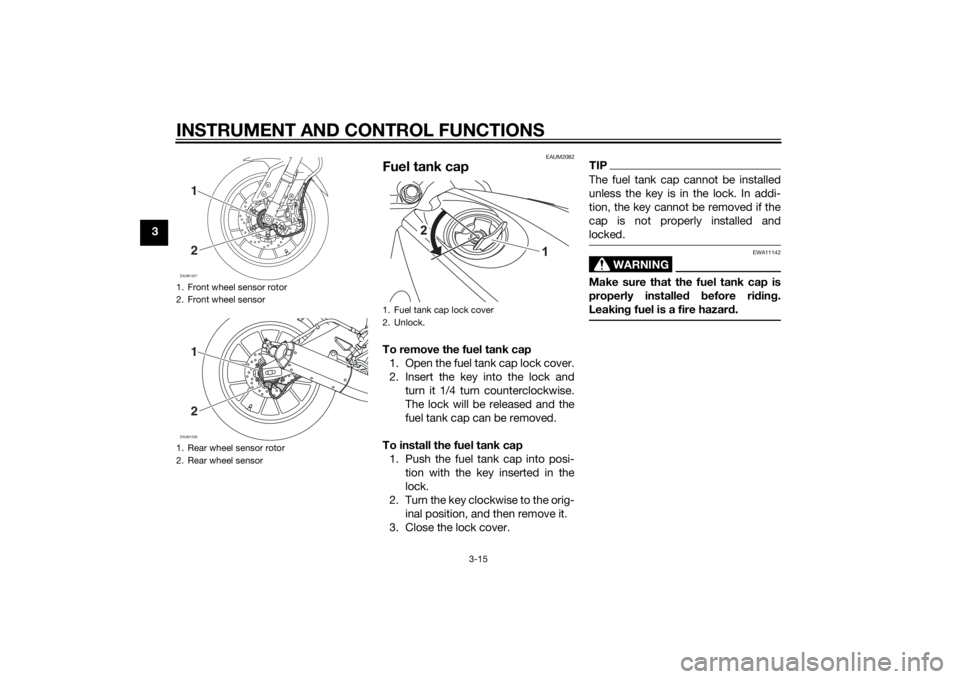
INSTRUMENT AND CONTROL FUNCTIONS
3-15
3
EAUM2082
Fuel tank capTo remove the fuel tank cap
1. Open the fuel tank cap lock cover.
2. Insert the key into the lock and
turn it 1/4 turn counterclockwise.
The lock will be released and the
fuel tank cap can be removed.
To install the fuel tank cap
1. Push the fuel tank cap into posi-
tion with the key inserted in the
lock.
2. Turn the key clockwise to the orig-
inal position, and then remove it.
3. Close the lock cover.
TIPThe fuel tank cap cannot be installed
unless the key is in the lock. In addi-
tion, the key cannot be removed if the
cap is not properly installed and
locked.
WARNING
EWA11142
Make sure that the fuel tank cap is
properly installed before riding.
Leaking fuel is a fire hazard.
1. Front wheel sensor rotor
2. Front wheel sensor
1. Rear wheel sensor rotor
2. Rear wheel sensorZAUM122712ZAUM122812
1. Fuel tank cap lock cover
2. Unlock.
U5D7E4E0.book Page 15 Thursday, July 10, 2014 3:01 PM
Page 31 of 96
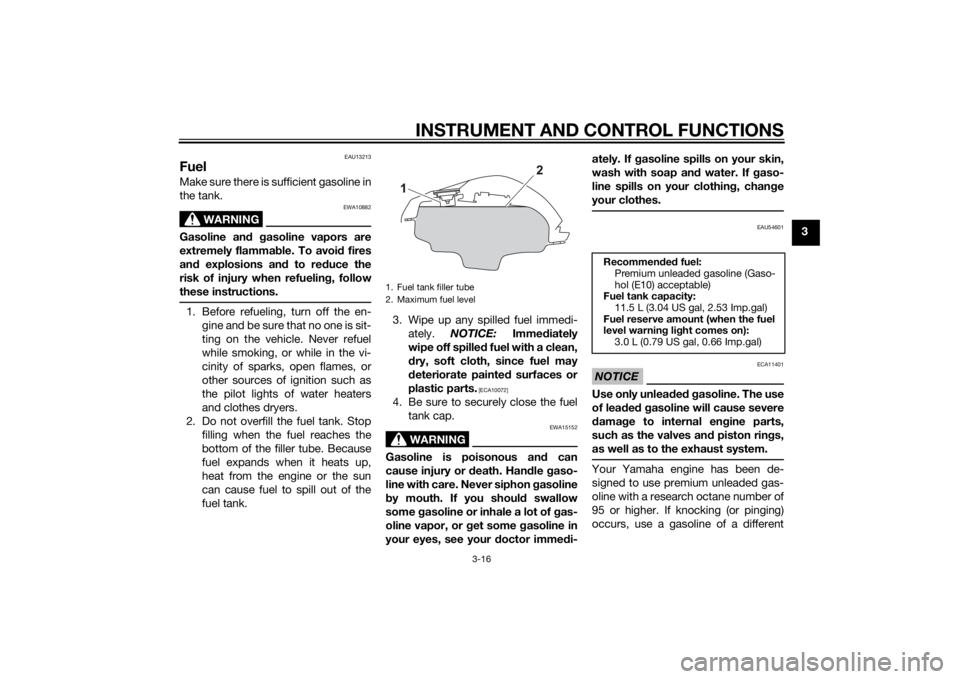
INSTRUMENT AND CONTROL FUNCTIONS
3-16
3
EAU13213
FuelMake sure there is sufficient gasoline in
the tank.
WARNING
EWA10882
Gasoline and gasoline vapors are
extremely flammable. To avoid fires
and explosions and to reduce the
risk of injury when refueling, follow
these instructions.1. Before refueling, turn off the en-
gine and be sure that no one is sit-
ting on the vehicle. Never refuel
while smoking, or while in the vi-
cinity of sparks, open flames, or
other sources of ignition such as
the pilot lights of water heaters
and clothes dryers.
2. Do not overfill the fuel tank. Stop
filling when the fuel reaches the
bottom of the filler tube. Because
fuel expands when it heats up,
heat from the engine or the sun
can cause fuel to spill out of the
fuel tank.3. Wipe up any spilled fuel immedi-
ately. NOTICE: Immediately
wipe off spilled fuel with a clean,
dry, soft cloth, since fuel may
deteriorate painted surfaces or
plastic parts.
[ECA10072]
4. Be sure to securely close the fuel
tank cap.
WARNING
EWA15152
Gasoline is poisonous and can
cause injury or death. Handle gaso-
line with care. Never siphon gasoline
by mouth. If you should swallow
some gasoline or inhale a lot of gas-
oline vapor, or get some gasoline in
your eyes, see your doctor immedi-ately. If gasoline spills on your skin,
wash with soap and water. If gaso-
line spills on your clothing, change
your clothes.
EAU54601
NOTICE
ECA11401
Use only unleaded gasoline. The use
of leaded gasoline will cause severe
damage to internal engine parts,
such as the valves and piston rings,
as well as to the exhaust system.Your Yamaha engine has been de-
signed to use premium unleaded gas-
oline with a research octane number of
95 or higher. If knocking (or pinging)
occurs, use a gasoline of a different
1. Fuel tank filler tube
2. Maximum fuel level
Recommended fuel:
Premium unleaded gasoline (Gaso-
hol (E10) acceptable)
Fuel tank capacity:
11.5 L (3.04 US gal, 2.53 Imp.gal)
Fuel reserve amount (when the fuel
level warning light comes on):
3.0 L (0.79 US gal, 0.66 Imp.gal)
U5D7E4E0.book Page 16 Thursday, July 10, 2014 3:01 PM
Page 32 of 96
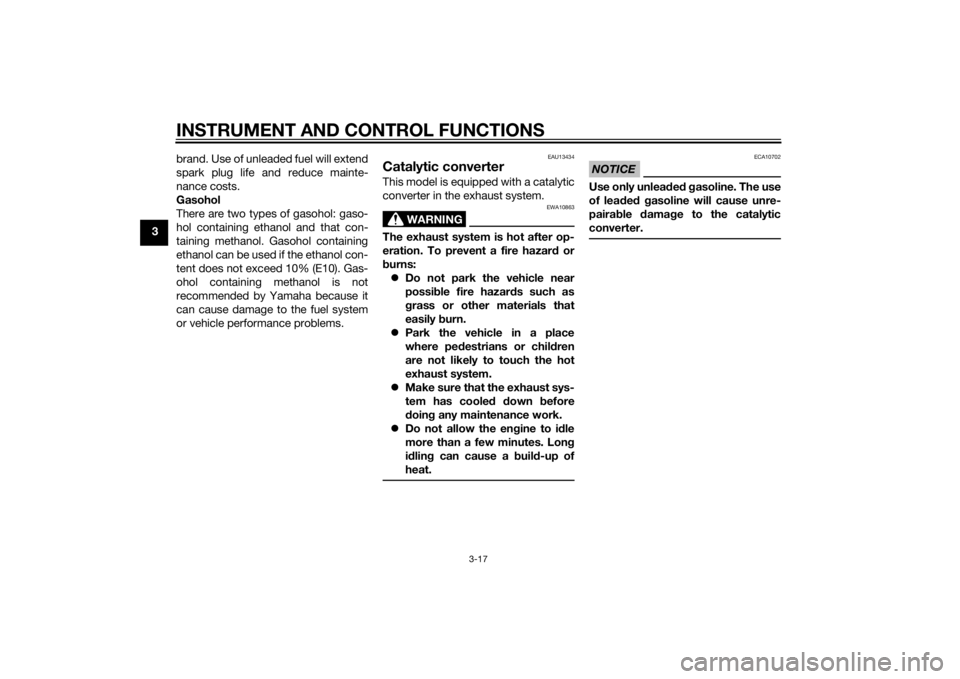
INSTRUMENT AND CONTROL FUNCTIONS
3-17
3brand. Use of unleaded fuel will extend
spark plug life and reduce mainte-
nance costs.
Gasohol
There are two types of gasohol: gaso-
hol containing ethanol and that con-
taining methanol. Gasohol containing
ethanol can be used if the ethanol con-
tent does not exceed 10% (E10). Gas-
ohol containing methanol is not
recommended by Yamaha because it
can cause damage to the fuel system
or vehicle performance problems.
EAU13434
Catalytic converterThis model is equipped with a catalytic
converter in the exhaust system.
WARNING
EWA10863
The exhaust system is hot after op-
eration. To prevent a fire hazard or
burns:
Do not park the vehicle near
possible fire hazards such as
grass or other materials that
easily burn.
Park the vehicle in a place
where pedestrians or children
are not likely to touch the hot
exhaust system.
Make sure that the exhaust sys-
tem has cooled down before
doing any maintenance work.
Do not allow the engine to idle
more than a few minutes. Long
idling can cause a build-up of
heat.
NOTICE
ECA10702
Use only unleaded gasoline. The use
of leaded gasoline will cause unre-
pairable damage to the catalytic
converter.
U5D7E4E0.book Page 17 Thursday, July 10, 2014 3:01 PM
Page 33 of 96
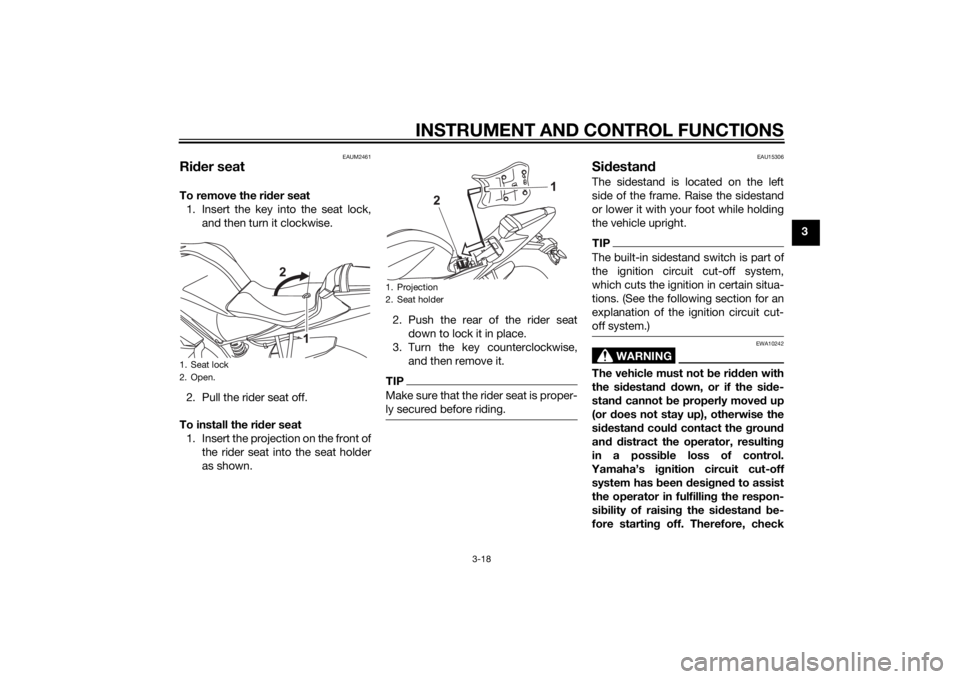
INSTRUMENT AND CONTROL FUNCTIONS
3-18
3
EAUM2461
Rider seatTo remove the rider seat
1. Insert the key into the seat lock,
and then turn it clockwise.
2. Pull the rider seat off.
To install the rider seat
1. Insert the projection on the front of
the rider seat into the seat holder
as shown.2. Push the rear of the rider seat
down to lock it in place.
3. Turn the key counterclockwise,
and then remove it.
TIPMake sure that the rider seat is proper-
ly secured before riding.
EAU15306
SidestandThe sidestand is located on the left
side of the frame. Raise the sidestand
or lower it with your foot while holding
the vehicle upright.TIPThe built-in sidestand switch is part of
the ignition circuit cut-off system,
which cuts the ignition in certain situa-
tions. (See the following section for an
explanation of the ignition circuit cut-
off system.)
WARNING
EWA10242
The vehicle must not be ridden with
the sidestand down, or if the side-
stand cannot be properly moved up
(or does not stay up), otherwise the
sidestand could contact the ground
and distract the operator, resulting
in a possible loss of control.
Yamaha’s ignition circuit cut-off
system has been designed to assist
the operator in fulfilling the respon-
sibility of raising the sidestand be-
fore starting off. Therefore, check
1. Seat lock
2. Open.
1. Projection
2. Seat holder
U5D7E4E0.book Page 18 Thursday, July 10, 2014 3:01 PM